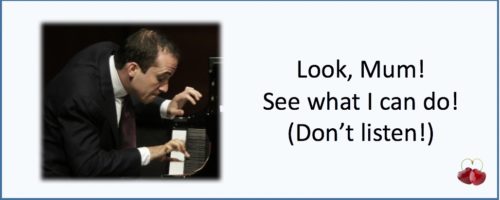Listening Cherry 34 – Aping the goal
Imagine a concert pianist, on stage playing a virtuoso sonata by Liszt. Wonderful patterns of notes a beautiful and moving (in all senses) soundscape of colours, major and minor keys, cascades, soft then loud, etc. etc. This is a public display of expertise which is a wonder to behold. Expert behaviour, hard earned and hard learned over a long period of time.
But what if someone claiming to be a teacher decided to teach pupils such expert behaviour, by focussing on the visible observable aspects of performance. Their pupils would be encouraged to sit at a piano and splash away at the keys, imitating the observable rapid movement of the fingers, the coordination of the hands, and the foot movements on the pedals. All without learning the means of playing the piano, disciplined controlled slow movements, simple scales, starting with easy pieces. The result may look enchanting an accurate depiction of what it takes to be a famous pianist – but the sound would be awful. All without paying attention to the sound.
This would be a case of aping the goal (where ‘ape’ means ‘to imitate someone or something, especially in an absurd or unthinking way’) at the cost of dealing with the major issue of sound.
In many approaches to listening comprehension exercises we ape the behaviour that is the goal, while minimising the amount of detailed instruction that provide the means towards this goal – increasing students’ mastery of the sound substance. We are thus goal-obsessed, and we starve our learners of the means of achieving the goal.
We expect learners to role-play native speaker/expert listener behaviour in listening comprehension lessons by catching meanings. But we don’t teach them how to perceive words in the sound substance of speech.
We get them to ape the goal behaviour (the describable elements of it) without giving them the means (the dimension of sound) whereby the full goal behaviour can be achieved.
The belief seems to be that through undergoing repeated listening comprehension exercises of this type, learners will eventually learn how to perceive words in the sound substance. It is as if we are leaving the undescribable (or what we believe to be the undescribable) to work its magic on the learners perception unconsciously while we focus attention on what we can describe.
Image from here. Oh, and Igor Levit, who is pictured is a wonderful pianist who produces the most gorgeous sounds.



Leave a Reply